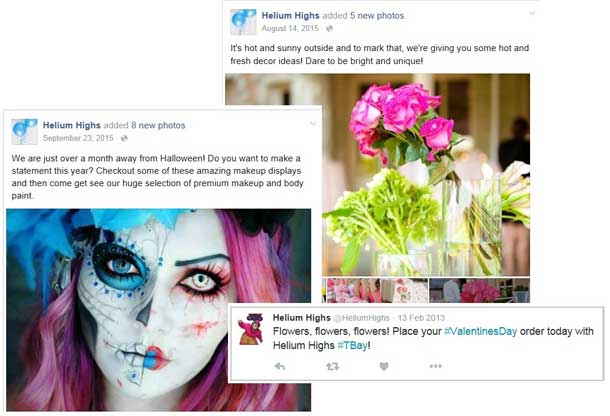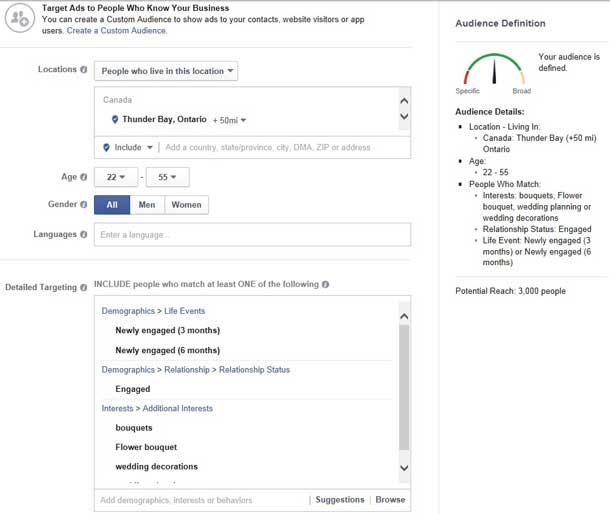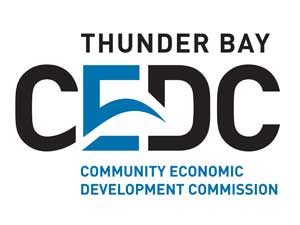
Social Media Strategy and Your Business Growth Goals
THUNDER BAY – Entrepreneurship – New year; new achievements! Your business has goals – increased sales, more customers, stronger loyalty, steady growth – and as an entrepreneur, it’s up to you to reach those milestones. Every January, people of all walks of life, including small business owners, set out to accomplish a new set of objectives regarding their careers, financial plans, and family lives, etc. Why should your small business marketing be exempt?
The Thunder Bay Community Economic Development Commission (CEDC) and Thunder Bay & District Entrepreneur Centre (EC)’s Digital Resources and Outreach service offers assistance in the area of marketing and communications, including social media, to new, aspiring, and existing entrepreneurs. If you’re one of the many businesses whose social presence could use a boost, contact the Entrepreneur Centre to receive free counseling, advice, and information to get your social presence working for you.
Social media is an increasing priority for businesses of all types and sizes, and if you’re one of the few that aren’t leveraging the power of social marketing, you could be losing out on maximizing your exposure, reaching new markets, and accessing customer insight, among other things.
For many entrepreneurs, social marketing presents a huge learning curve as they begin to navigate the social landscape. But the learning doesn’t stop there. Your social media marketing is a constant work in progress, so don’t stay stagnant and let your business suffer from repeated mistakes.
This 2016, try adding an improved social presence to your resolutions list. As a starting point, here are some important things most lacking in small business social marketing, and what you need to be doing differently in 2016.
- Develop and consistently use your brand narrative
Whether you know it or not, your business has a brand. Your brand is a feeling – all those intangible thoughts and perceptions formed as a result of the way you work, communicate, and do business. Take the time to define your brand and harness its power by conveying it through your social media activity.
Too many businesses do not realize their own brands. If you’re one of those businesses, think of it this way: what kind of personality does your business have? Define key attributes (fun, polite, silly, professional, forthright, inspirational, crude, optimistic, etc.). Keep in mind who your customers are, their characteristics, and how they want to receive communication. Your brand voice should also reflect your company values – things you like, things you dislike, causes you support, and so on.
It is crucial that you pinpoint these characteristics and bake them into your social communication. Without attributing any of those traits, there is nothing to shape your brand voice, making it very easy to lose, as there are many different ways to say the same thing. Review the following example:
“Call now!”
“Contact a representative in your area.”
“Give us a call, why don’tchya?”
Strong branding breeds loyalty, and can put your business ahead of the competition in a big way. Your brand should drive your social media activity and influence your tone of voice. Marketers, social media professionals, and every day entrepreneurs should convey their brands through their social communications to maximize their efforts.
- Create a content calendar
Business tends to be cyclical. The cold winter months are a dead zone for many businesses, but are followed by the promise of spring. Valentine’s Day, Mother’s Day, and Father’s Day pass, while leading into camping season, graduations, weddings, BBQs, long weekends, and before we know it, it’s back-to-school time. After Thanksgiving and Halloween, winter is upon us again as we move into the holidays. And it starts all over.
The peaks and lulls will vary from business to business and industry to industry, but odds are, your business operates on some sort of cycle. Let your social media activity be guided by your typical business cycle. Map out those peak periods to give you a starting point and ideas to work from when sourcing content.

For example, a flower shop may have a content calendar that looks like this:
January-February – Valentine’s Day
April-May – College and University graduations; Mother’s Day; Administrative Professionals’ Day; bridal showers; spring flowers
June – Highschool graduations; Father’s Day
July-August – Wedding season; summer flowers
October – Fall flowers
November-December – Holiday arrangements; poinsettias; winter flowers and plants
Filler Content – Birthdays; Thank-you gifts; baby showers; gifts for co-workers, employees, employers; wedding anniversaries
Use your content calendar to help you find valuable and relevant articles, photos, videos, infographics, and any other content that engages your audience and spreads the word about your business. During off-peak periods, stay active on social media with ‘filler content’ – content that isn’t necessarily seasonal and can be posted in between busy spurts.
- Strategize your ads
If you’re going to spend money on paid ads and sponsored (‘boosted’) posts, you really should have a goal in mind. Set an objective when placing ads, and use appropriate targeting options to get your ads seen by the right people. The mistake many businesses tend to make is taking out very few big-budget ads with little strategy behind them, often ‘mass targeting’ their market.
Advertisements that are too broad, vague, and un-targeted fail to capture an audience because they aren’t memorable and they do not strike a chord with the people you’re trying to connect with. They are non-specific and blend in with the rest of the ad bombardment.
Your ads will be more effective if you organize them to promote different products and services to different segments of your target market. Facebook’s targeting options are plentiful, and there is no shortage of information when it comes to narrowing in on your target market.
In the flower shop example, that business may advertise bridal flowers to newly engaged couples and people who have expressed an interest in wedding planning, bridal flowers, and bridal bouquets. In another campaign, they may advertise Valentine’s Day bouquets to people who are married, engaged, or in a relationship.

Social media networks employ literally hundreds of thousands of algorithms that are able to make presumptions about our demographic information and interests by analyzing our web browsing history, credit card charges, and purchasing information provided by store loyalty cards. As a business, you can utilize this data to reach qualified sales leads and generate income from your ads.
- Optimize your profiles
Your social media profiles are a reflection of your business, and your brand as well as your key messaging should be conveyed, much like it is on your website. For you businesses that don’t (yet) have a website, your social media is all you’ve got, and it is all the more important to make the best of it.
How well your social media promotes your brand, educates your followers, and prompts them to visit your website will ultimately improve or worsen its effectiveness. Optimize your social media by choosing the right links, inputting your company information, and integrating your brand as such:
- Links – Choose your links wisely. As a general rule, your Twitter handle, Instagram username, as well as your Facebook URL and any other social media usernames should be short and easy to remember. Make use of acronyms and exclude suffixes such as Inc., Corp., etc. For example, the Thunder Bay Community Economic Development Commission’s Facebook URL is facebook.com/ThunderBayCEDC; and our Twitter handle is @TBCEDC.
- Company information – Be thorough and fully disclose all corporate information and key messaging in the descriptions of your social media pages. Facebook allows you to list a short as well as a long description and impressum (for legal matters), so make use of this space by explaining your business and the services you offer. List hours of information, a website link, email address, mailing address, phone and fax numbers where appropriate.
- Integrate branding – Your social media profiles should not only display your logo, but your brand identity and visual themes too. Networks like Facebook, Twitter, and YouTube give you a profile picture as well as a cover photo as a backdrop. As your profile picture is the one that displays on any social activity (Tweets, posts, etc.), upload your company logo to maximize its exposure. Use your cover photo for more decorative purposes, or to advertise promotions. Your image files should fit the pre-set dimensions, and be sure to follow the rules, terms, and conditions of each social network before adding text and promotional information to your display pictures.
Your small business marketing is an ongoing process and the businesses who see high returns on their social media investment are always learning, experimenting, and building upon their accomplishments.
If your business is interested in maximizing its social media marketing, the Entrepreneur Centre’s Digital Resources and Outreach service is here to help. Whether you’re just getting started or are looking for new and different strategies, the Entrepreneur Centre can offer free information, advice, referrals, and training to help you find new and better ways of marketing your products and services. Call (807)625-3452 or email apenko@thunderbay.ca to learn more.
The Thunder Bay and District Entrepreneur Centre (EC) offers FREE and confidential services to help small businesses start up, expand, and succeed. The Entrepreneur Centre can assist with writing a business plan, securing funding, marketing your products and services, and accessing other available resources in the community. They also provide free workshops and training seminars to equip and empower small businesses to perform the best they can. For more information or to schedule an appointment, call (807)625-3960 or visit www.EntrepreneurCentre.ca.
 |
 |







